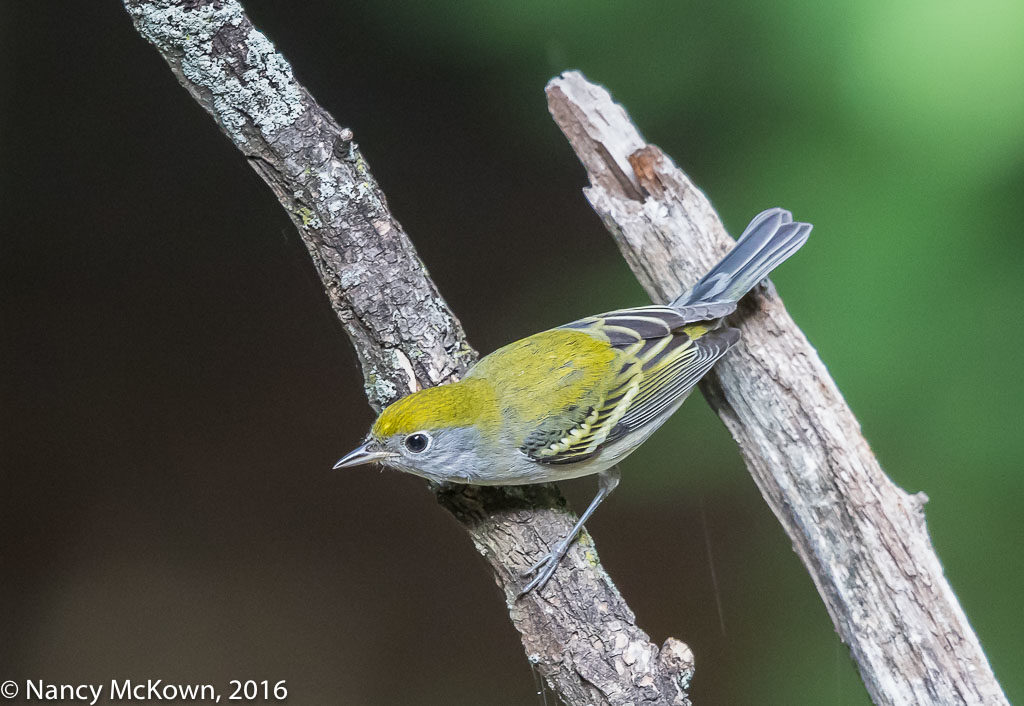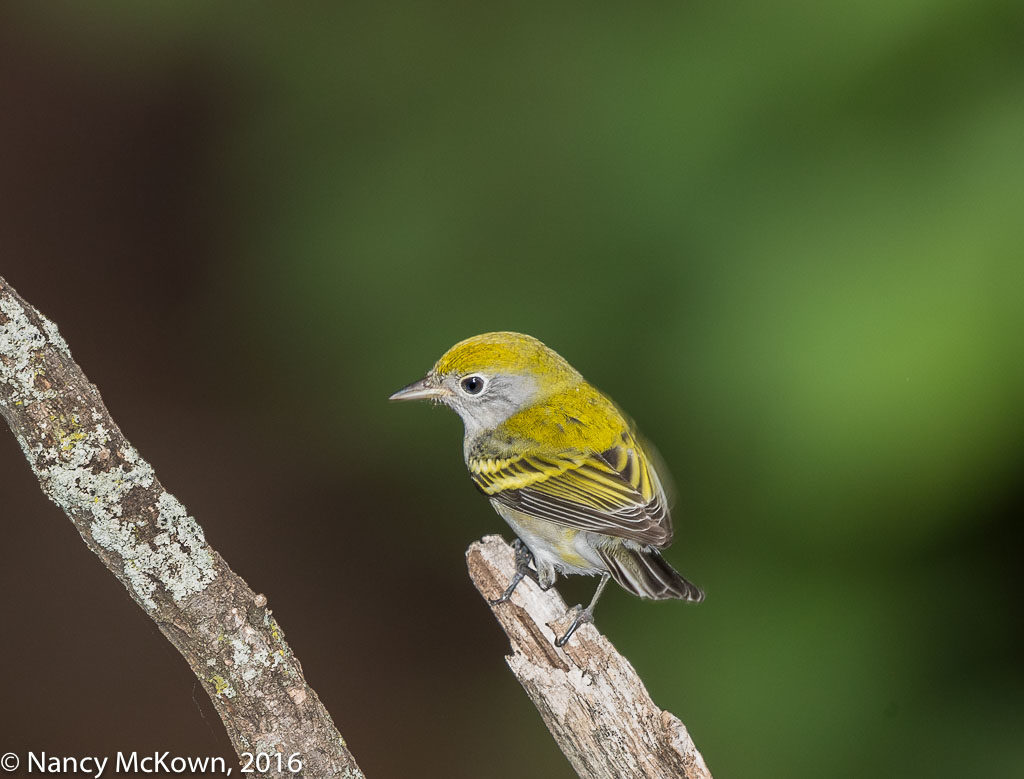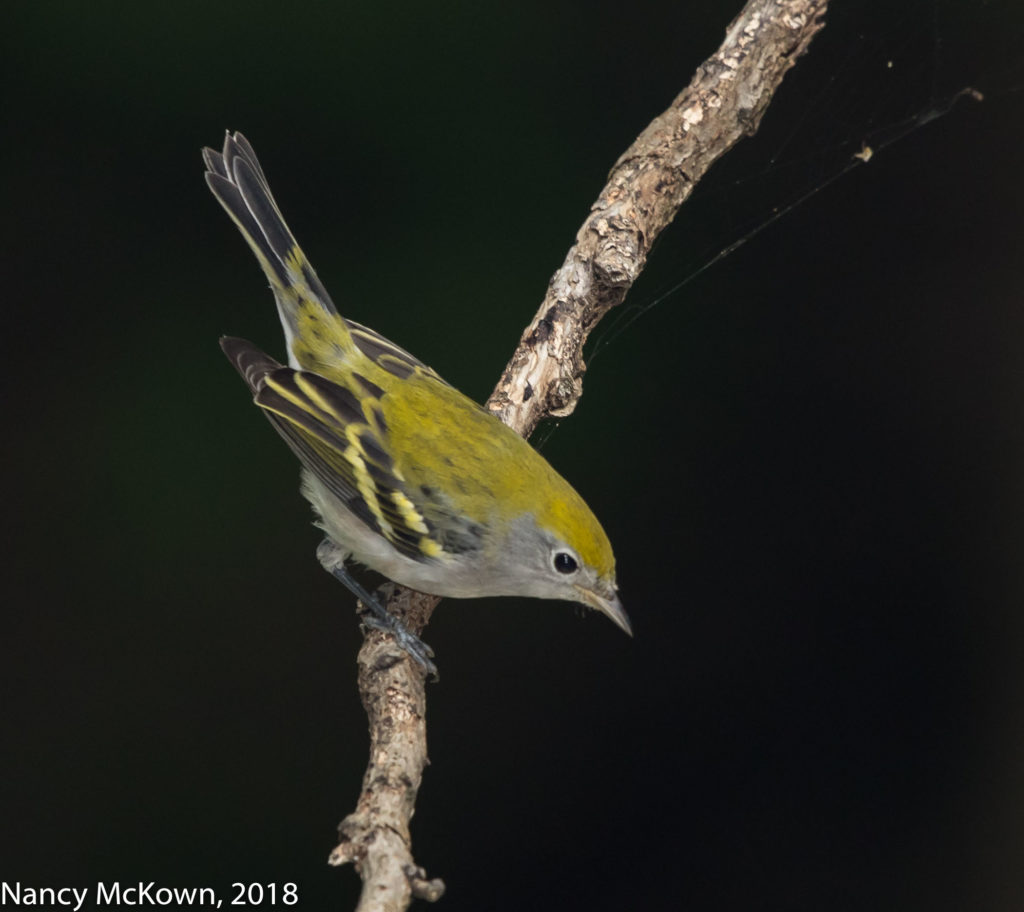Photographing an Immature Chestnut Sided Warbler
This little immature Chestnut Sided Warbler visited the fountain late in October, 2016. He is very unlike his swanky male counterpart photographed last Spring. Plumage on his crown and back is a chartreuse yellow resting atop a solidly gray base. Prominent white eye rings stand out. No chestnut color markings are apparent.

ISO5000; f/6.3; 1/400 Second
It was early in the morning of what promised to be a sunny day. The flash was not attached. As usual, the camera was set to Manual Mode with Auto ISO.
The heavily filtered light was spotty and uneven, enough to throw off the camera’s light meter (set at evaluative metering mode). In Manual mode, I can ignore the camera’s meter readings and underexpose or overexpose as needed, adjusting one or more of the exposure variables to compensate for uneven light. This shoot was a good opportunity to play with the Automatic Exposure Compensation dial with the camera set to Manual mode and Auto ISO.
Automatic Exposure Compensation in Manual Mode with Auto ISO
Automatic Exposure Compensation combined with Auto ISO and Manual functionality in some Canon DSLR cameras seem to me very peculiar.
I had mistakenly assumed the AEC function on my Canon 5D Mark III DSLR worked in Manual “M” Mode as long as I set the camera to Auto ISO. After all, the camera could adjust exposure compensation by changing the ISO. However, on many Canon Cameras, setting the AEC function does nothing at all when the camera is set to “M” Manual mode. The AEC function on the camera will not work because it will not override the M manual settings (aperture, shutter, ISO) the photographer has set, even if the photographer set the camera to determine the ISO (Auto ISO).
As Canon keeps adding cameras to its fleet, this functionality of allowing automatic exposure compensation to integrate with Manual mode and Auto ISO was included in the following (and most recent) Canon DSLR cameras: EOS-1D X, EOS-1DX Mark II, EOS 5DS / EOS 5DS R, EOS 7D Mark II, and EOS 80D. Manual Mode with Auto ISO is essentially an “auto exposure mode” without a label.
Basic Auto Exposure Compensation -AEC
The light metering systems on modern cameras have all sorts of algorithms to figure out what exposure is proper for the scene. Many times lighting conditions are not average and the camera’s light meter can calculate the wrong exposure for the existing light.
Most digital cameras allow photographers to over ride the camera’s exposure settings with an “auto-exposure compensation” dial. When you play with the AEC dial on your camera, you are essentially changing the camera’s “optimal” autoexposure reading. NOTE: A simple formula to adjust exposure using the camera’s histogram can be found at this post.

Immature male (or female?).
Motion Blur on the right wing and tail feathers.
ISO5000; f/6.3; 1/400 Second
Overriding Auto Exposure Settings
AEC is all about overriding some component of the automatic exposure functionality of your camera. If you use Manual mode to specifically set fixed values for shutter, aperture, and ISO, no AEC is possible. In Manual mode with Auto ISO engaged, ISO is the only exposure variable accessible to change exposure. The AEC dial can be turned to the right (+) to add light, thus raising the ISO; or turned to the left (-) to subtract light, thus lowering the ISO. The shutter speed and aperture settings that the photographer manually set will not change.
Pre-Set Thresholds for Auto ISO
Whenever using Auto ISO in any auto mode (P, Tv, Av) or Manual mode (M), take the time to go into the camera’s menu system to constrain auto ISO with pre-set thresholds. This will prevent the floating ISO from going sky high and producing speckled unusably noisy images. The minimum and maximum ISO ranges that you set should be based on your personal preferences and the noise reduction technology built into your camera’s sensor.
NOTE: When the light is low, take a second to check the exposure readings on the meter bar in the viewfinder to determine if your pre-set ISO value limitations are preventing the camera from achieving proper exposure. This meter bar is informational only and will not change the exposure parameters set in Manual mode by the photographer.

ISO800; f/8; 1/250 Second








